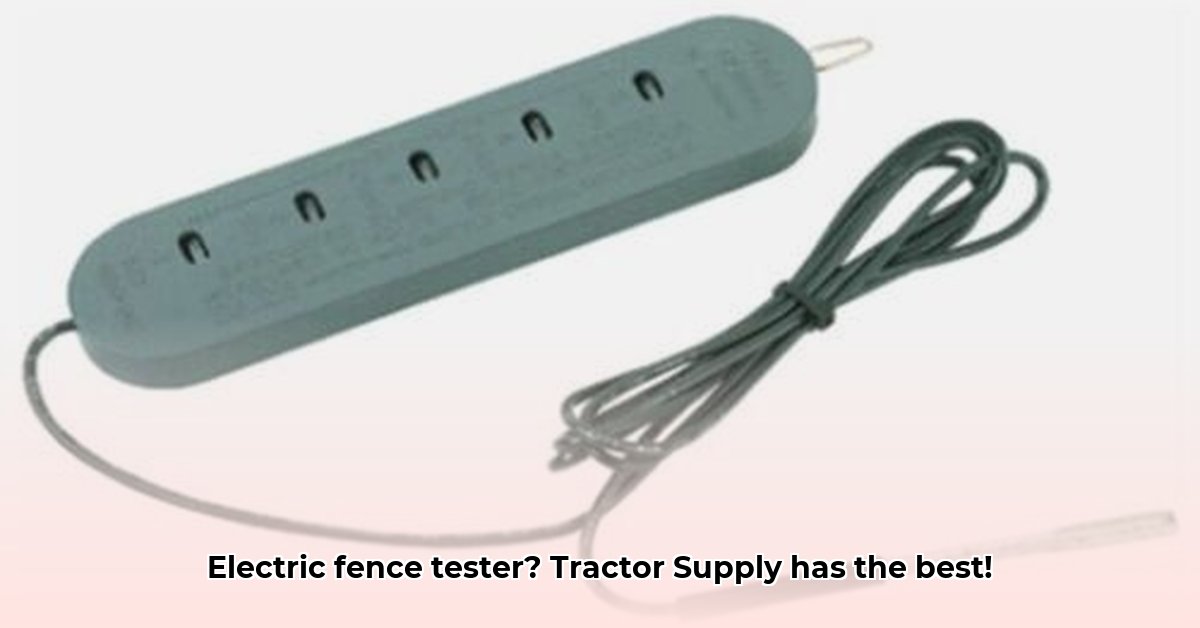
Maintaining a reliable electric fence is crucial for efficient and humane livestock management. A faulty fence can lead to livestock escapes, injuries, and increased workload. Regular testing with a reliable electric fence tester is the key to preventing these issues, and Tractor Supply offers a range of options to suit your needs. For additional livestock management resources, check out this helpful guide on chicken feeders. This guide will help you choose the right tester and use it effectively to keep your animals safe and your farm running smoothly.
Choosing the Right Electric Fence Tester: Matching Needs to Tractor Supply's Offerings
Tractor Supply offers a variety of electric fence testers, each with specific features and capabilities. Understanding these differences is crucial for making an informed purchase. Do you need a simple voltage checker or a sophisticated ground fault detector? The answer depends on the size and complexity of your farm.
Here's a comparison to help you decide:
| Feature | Basic Voltage Tester | Ground Fault Detector | Combination Tester | Ideal For |
|---|---|---|---|---|
| Primary Function | Measures voltage only | Locates breaks and shorts in the fence line | Measures voltage and locates ground faults | Small farms, quick checks; Larger farms; All farm sizes |
| Voltage Range | Typically 0-5,000 volts | Typically 0-10,000 volts | Typically 0-10,000 volts | Depends on fence length and voltage requirements |
| Ground Fault Detection | No | Yes | Yes | Essential for troubleshooting complex fence issues |
| Cost | Generally lower | Generally higher | Moderate to high | Budget and needs |
Consider this: A longer fence or one prone to issues will benefit greatly from a ground fault detector. Its ability to pinpoint the exact location of a problem saves considerable time and effort compared to a basic voltage tester.
How to Use an Electric Fence Tester: A Step-by-Step Guide
Using an electric fence tester correctly is essential for accurate readings and your safety. Always prioritize safety when working with electric fences.
Step 1: Disconnect the Power. Before you begin, always disconnect the power to your electric fence. This is non-negotiable for safety.
Step 2: Connect the Tester. Carefully connect the tester leads to your fence wire. Consult your tester's manual for specific instructions on proper placement (typically, the leads are placed across a section of the energized wire).
Step 3: Check the Reading. Observe the tester's display to note the voltage level. If your tester has ground fault detection, this will also be indicated.
Step 4: (Optional) Brief Power Check Briefly reconnect the power to your energizer to verify the reading. Immediately switch the power off afterwards. This confirms the tester accurately reflects the fence’s output.
Pro Tip: Test multiple points along a long fence, especially at gates and where the terrain changes.
Troubleshooting Common Electric Fence Problems
Low or inconsistent readings indicate potential issues. Here's how to identify and fix them:
Low Voltage: This is usually due to poor connections (corroded wire, loose connectors), broken wire, insufficient ground connection, or a faulty energizer. Inspect the entire fence, paying close attention to connections, insulators, and the energizer itself.
High Voltage: While seemingly positive, this might indicate that the energizer is outputting too much power—a safety hazard. Check the energizer's settings; also inspect for damaged insulators that might be leaking the charge.
Ground Faults: Use a tester with ground fault detection capability to locate the area where current is escaping into the ground, often due to compromised grounding or damaged wire near the ground.
Remember: Regular inspections are proactive, preventative maintenance.
Essential Safety Precautions: Working Safely with Electric Fences
Electric fences carry a significant risk of electric shock. Always follow these safety procedures:
- Never touch a live fence. This is absolutely crucial.
- Always turn off the energizer before testing or repairing the fence.
- Use insulated gloves and wear appropriate protective clothing.
- Keep children and pets away from the fence during testing and maintenance.
- If you receive an electric shock, seek immediate medical attention.
Conclusion: Maintaining a Safe and Effective Electric Fence
Regular testing with a reliable electric fence tester from Tractor Supply is an investment in both livestock safety and farm efficiency. By following these guidelines, you can ensure your electric fence is functioning optimally, protecting your animals and saving you time and money in the long run. Choosing the right tester and using it responsibly is paramount for successfully managing your farm. Remember: a well-maintained fence is a safe fence.